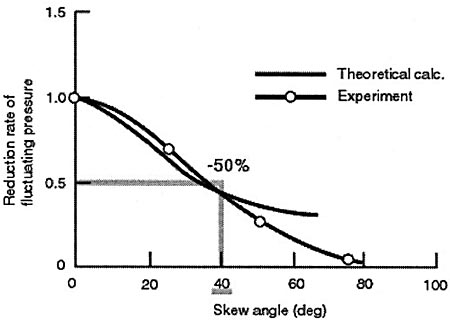|
4) LOW EXCITING FORCE PROPELLER (HIGHLY SKEWED PROPELLER):
The propeller exciting force is a vital cause for the hull vibration, being an important element related to the comfortableness aboard. When propeller blades pass near hull bottom, the pressure fluctuation resulting from cavitation acts onto the area as the exciting force. The propeller cavitation will be generated in a concentrating manner around the hull bottom. Fig.6 shows the increase of the pressure fluctuation. When cavitation is not generated, water pressure fluctuation is smoothly increased in accordance with the propeller shaft speed increased, however, when the cavitation is generated, the water pressure fluctuation will rapidly be increased, which will be a cause for the serious hull vibration.
| Fig.6 |
Increase of the pressure fluctuation when the cavitation is generated over the propeller |
Fig.7 Typical configuration of the HSP
| Fig.8 |
Conditions of the cavity volume being varied at each blade element for CP and HSP |
| Fig.9 |
Relation between the skew angle and the reduced amount of the water pressure fluctuation |

With the recent vessels from which high speed and high efficiency are expected, it will be impossible for the cavitation to thoroughly be eliminated. In that sense, efforts were made for devising the reduction of cavitation phenomenon, even if it cannot be avoided. One of the devices successfully realized for practical use is highly skewed propeller (HSP). Fig.7 show the typical configuration of the HSP. The receded angle as you see is the peculiar characteristics of HSP, and the angle is called skew angle. Usually the propellers with skew angle of 25 degree or larger is called HSP. Fig.8 shows the conditions of the cavity volume being varied at each blade element during the propeller in revolution for CP and HSP. The total cavity volume by all the blades will become the propeller exciting force. The CP with uniformed peak positions has apparently larger total volume of cavitation all over the blades, You will see that the peak positions differ greatly at each radius with HSP. That is to say, the generating/collapsing manner of the cavitation over the whole blades with HSP is averaged, with each timing of cavitation generation being deviated smoothly. Fig.9 shows the relation between the skew angle and the reduction of the pressure fluctuation. The pressure fluctuation is reduced by half at the 40 degree skewed. HSP is extremely effective for reducing the propeller exciting force, thereby improving the comfortableness aboard.
|